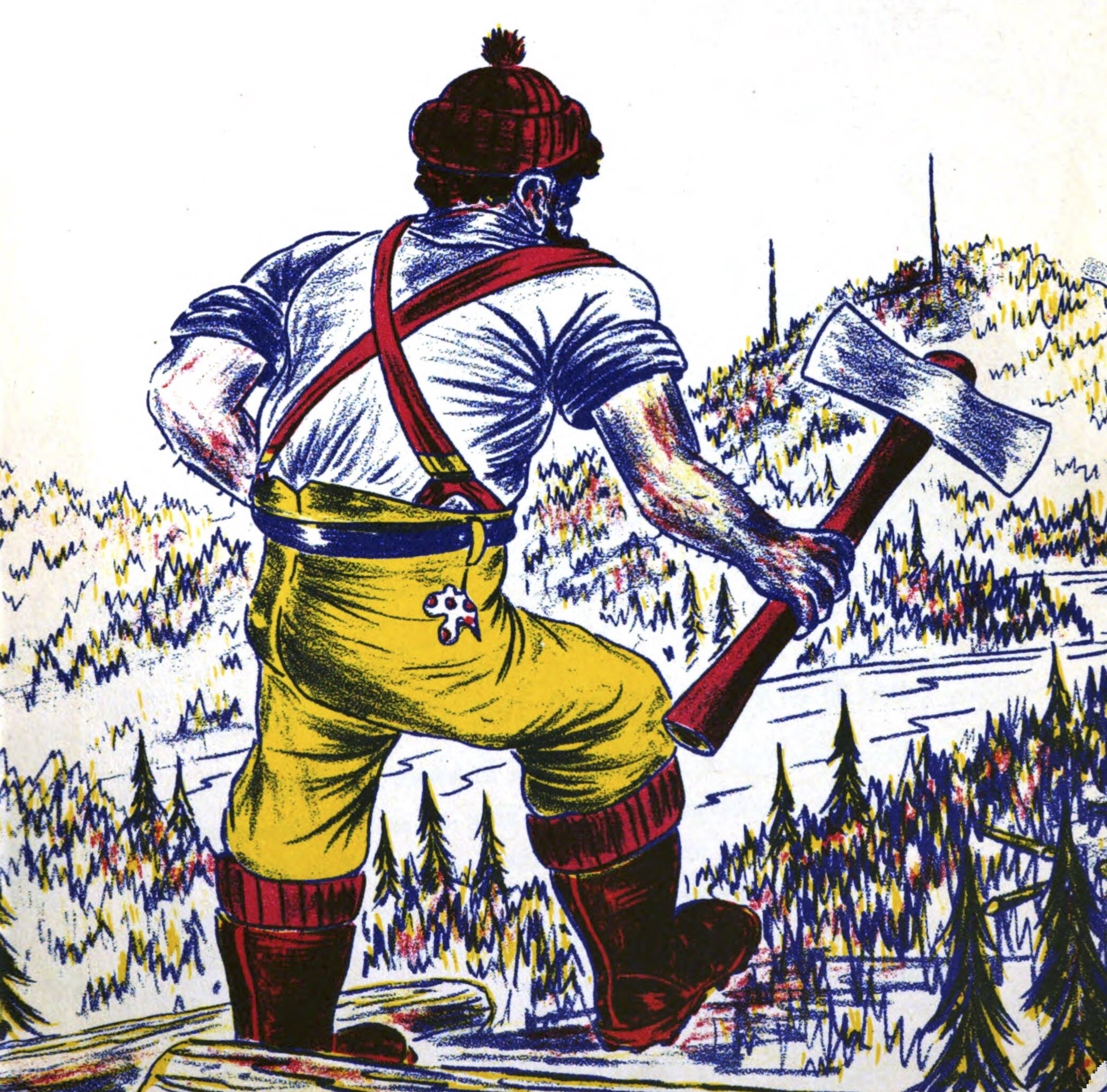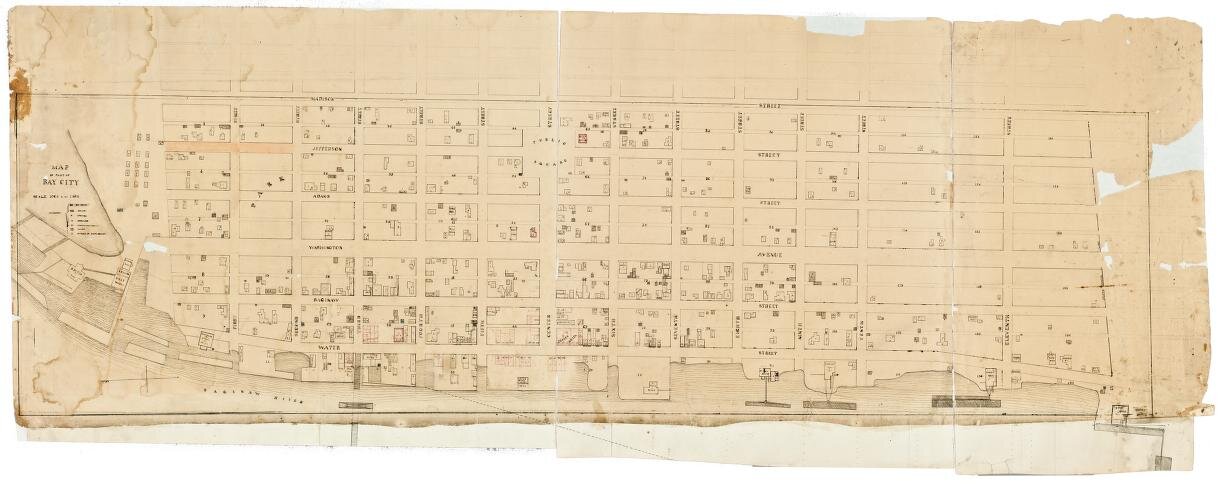Fabian "Joe" Fournier's Jawbone and the Mystery of the Tree Chopper's Choppers
Real-life Michigan lumberman Fabian Fournier inspired the Paul Bunyan legends, and myths surround the whereabouts of his remains.
In 1972 the Owosso Argus-Press asked, “Where is the Jawbone of Famed Joe Fournier?” Researchers occasionally contact the Sindecuse Museum staff with the same question.
Born in Quebec around 1840, Fabian “Saginaw Joe” Fournier was a lumber foreman in the tri-county area of Mid-Michigan. His story has continued after his death: Fournier is said to be one of the mighty, real-life inspirations for the Paul Bunyan character of American folktales. Despite cheerful connotations with Bunyan’s outsized adventures, the real Fournier’s death was far from rosy.
The French-Canadian lumberman was said to possess a second row of teeth (the phenomenon of excess teeth is known as hyperdontia), and Bay City tales said he was a rowdy customer when the lumbermen came to Bay City’s notorious “Hell’s Half Mile,” the waterfront saloon and red light district on the Saginaw River. He was known for fighting. “His most famous stunt was to bite a chunk out of a wooden bar with his massive row of double teeth,” wrote former Bay City News editor, historian and author of “Paul Bunyan: How a Terrible Timber Feller Became a Legend,” D. Laurence Rogers.
In the book “Holy Old Mackinac” (MacMillan 1942), full of tales on the tall side, Stewart H. Holbrook recalls an earlier fight between Fournier and an infamous Silver Jack Driscoll, a “moose of a man” born in Ontario. Holbrook describes a springtime fight at the Red Keg Saloon in Averill, Michigan in blow-by-blow detail, including Fournier’s signature move, headbutting, with “a head, by the way, reputed as hard as a boiler plate.” When the tables turned and Driscoll got the upper hand, he refrained from the custom of stomping on Fournier with his spiked logging boots, instead buying everyone in the bar a drink, including a double brandy for the beaten Fournier.
The Saginaw River lines the lower edge of this map of a portion of Bay City from around 1865, U-M Library Digital Collections. William L. Clements Library Image Bank. University of Michigan. Accessed: September 24, 2021.
Then, in November of 1875 or Summer of 1876, depending on the source, Fournier was bludgeoned to death on the gangplank of a picnic steamer returned to Hawkin’s dock in Bay City. Holbrook wrote that some of Fournier’s remains were buried “somewhere in the desolate and unkempt paupers’ graveyard of St. Joseph’s parish” in Bay City. He wasn’t entirely laid to rest. Some of his remains were exhibited at the trial of his murderer, Blinky Robertson. Holbrook wrote:
“For reasons not now clear, Joe’s massive skull was used as evidence. Old timers tell that the skull was for many years a prized exhibit in the Bay City courthouse where its double thick bone and double rows of teeth were the marvel of all who saw it.”
Fournier’s great-great niece, Cheri Thonerfelt, recalls her mother’s story:“When she was a little girl her family would visit other family in Bay City, MI. Her father, coming from a medical family, took her down to the Bay City Museum to see the skull of Fabian Fournier, which was on display there due to the 2 complete rows of teeth. It was certainly an oddity and because Fabian Fournier's family relocated to the Bay City area from Canada, somehow, the skull was in the family's possession.”
Did the display of Fournier’s remains continue after the trial?
Before he passed away, Rogers floated a U-M connection in a 2016 Hour magazine story by Jeff Waraniak. In “Terrible Timber Fellers,” Rogers noted, “Holbrook’s contention that the jawbone was marveled at by students at the University of Michigan Dental School for years.”
We have been unable to confirm whether the University of Michigan ever hosted Fournier’s remains. Responding to occasional queries, the Sindecuse Museum, in collaboration with our research allies around campus and The Historical Museum of Bay County, has not found any institutional records regarding Fournier’s presence at the University of Michigan nor information on his final resting place.
Anatomical examples and anomalies were certainly studied by students of dentistry and medicine at the time. The Sindecuse Museum holds records of dental students working with human remains in classroom settings, and variations of human dental structures would have certainly been of interest at the School of Dentistry. The earliest official study collections at the School of Dentistry began in the 1880s, a few years after Fournier’s death, when professor Corydon Ford gave the school 500 human and animal skulls for educational purposes. Following that initial gift, two Ohio brothers and U-M alums, Dr. William Mitchell and Dr. L. J. Mitchell, also donated over 500 bone specimens in 1904.
If you may have any information on the legend of Fabian Fournier’s jawbone being present at the University of Michigan, we would love to hear about it! Leave a comment below, or email any clues you may have to dentalmuseum@umich.edu. For general inquiries about Fabian Fournier, contact Jamie Kramer, Research Librarian at the Bay County Historical Society, at jkramer@bchsmuseum.org.
Thanks to Samuel Fitzpatrick and the Bay County Historical Society for their assistance. If you’d like to participate in one of the Bay County Historical Society’s tours, of Hell’s Half Mile, there are two tomorrow (10/2/2021) and, for future dates, keep an eye on their Events page!


